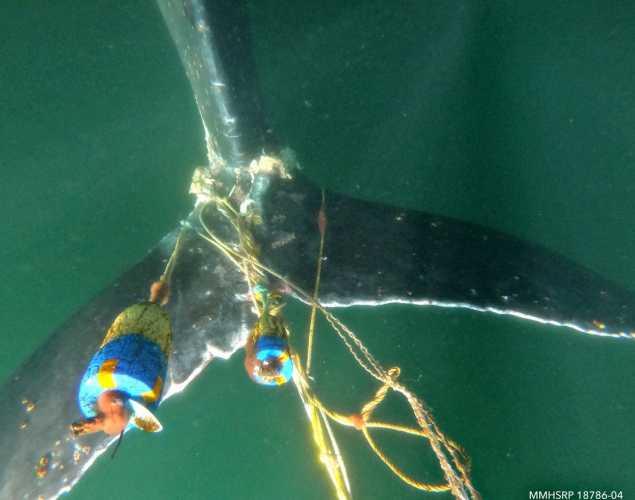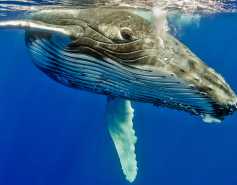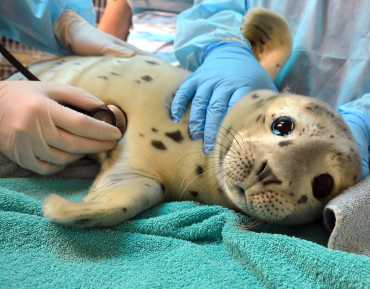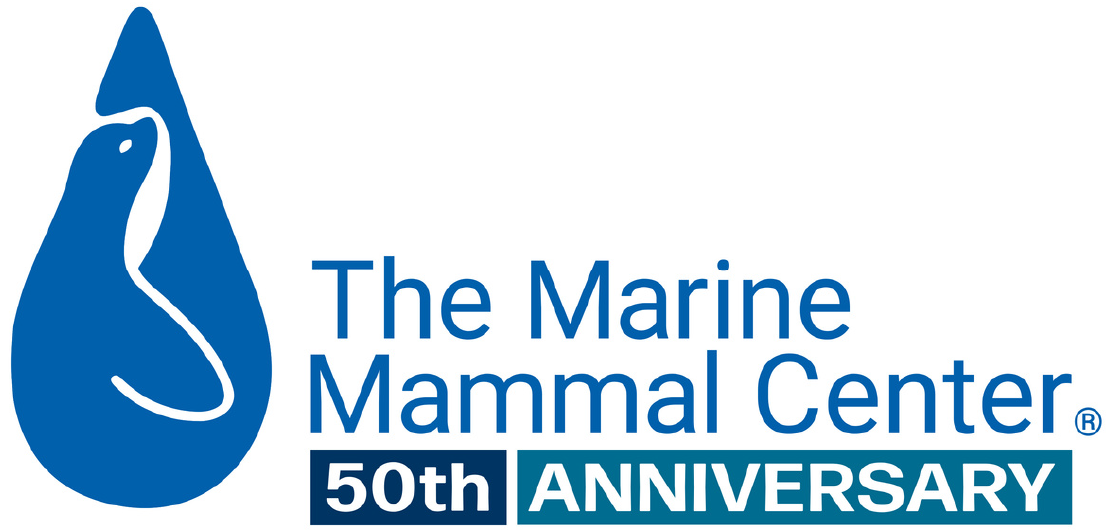
Severely Entangled Whale in Monterey Bay Freed
- Entanglement
Severely Entangled Whale in Monterey Bay Freed by Dynamic Team Including Experts from The Marine Mammal Center
Multiple sets of fishing gear were so heavy, they ‘anchored the whale in place.’
A trained response team, including several team members from The Marine Mammal Center, freed a humpback whale in Monterey Bay after tracking it for several days. It had become so severely entangled and weighed down by commercial Dungeness crab fishing gear that it could not move.
“It takes a true collaborative effort for a mission like this to succeed because there are so many moving pieces, such as weather conditions, distance from shore, and simply the ability to locate the entangled whale,” said Julia O’Hern, Operations Manager at The Marine Mammal Center’s Moss Landing triage center, and a key team member in the response to this whale.
Our work responding to entangled whales is absolutely critical and it’s going to take research, innovation and partnerships with fishermen, industries and agencies to solve the more complex problems that lead to entanglements in the first place.
The successful response was the result of a truly effective and dynamic collaboration of teams from The Marine Mammal Center, Marine Life Studies (WET)®, Moss Landing Marine Laboratories, National Marine Sanctuaries West Coast Region, and U.S. Coast Guard.
This was the third time an entangled whale off the West Coast has been freed in about a month. Responders also freed a humpback whale off Santa Cruz Island in mid-April, and a gray whale near Port Angeles, Washington in late April.
A California Department of Fish and Wildlife vessel first reported the entangled humpback whale about 11:15 a.m. on Saturday, May 16. A team responded Saturday afternoon, documenting the entanglement. Responders reported that the line was wrapped repeatedly around the whale’s tail, cutting into its flesh. The team tried to attach a telemetry tracking buoy to the 35-40 foot whale. They lost the opportunity when the entangling lines shifted, pulling the buoys underwater.
A team returned to the whale on Sunday. They successfully attached a telemetry tracking buoy to the entangling gear. They were also able to further assess the entanglement to support a response plan. Unfortunately, weather conditions deteriorated and the team then had to leave the whale.
On Monday morning, with the addition of the U.S. Coast Guard and other network volunteers, the team returned to the whale. By about 1 p.m., they had cut the whale free of the fishing gear. They found that the entanglement involved three sets of commercial Dungeness crab gear.
It is believed the whale first became entangled and began dragging a crab pot that caught two additional pots and associated lines and buoys. The weight of three combined sets of gear stopped the whale from swimming.
The removal of the gear greatly improves the chances of survival for the whale. However, its outlook remains uncertain. Humpback whales have rebounded in number off the West Coast in recent decades. However, threats to their recovery remain. Entanglements have been identified by NOAA’s National Marine Fisheries Service as the leading cause of mortality to large whales in the United States.
Learn More
{"image":"\/Animals\/Wild\/Humpback whale\/cropped-images\/humpback-whale-calf-shutterstock-0-592-4000-1845-1602378147.jpg","alt":"humpback whale underwater","label":"Cetaceans","title":"Humpback Whale","link_url":"\/animal-care\/learn-about-marine-mammals\/cetaceans\/humpback-whale","type":"page"}

{"image":"\/People\/Action\/Response\/cropped-images\/ryan-berger-kathi-george-whale-disentanglement-photo-c-bob-talbot-279-0-3562-2782-1603835250.jpg","alt":"three trained responders work on a whale disentanglement","title":"The Marine Mammal Center Expands Entangled Whale Response Efforts","link_url":"https:\/\/www.marinemammalcenter.org\/news\/the-marine-mammal-center-expands-entangled-whale-response-efforts","label":"News Update","date":"2019-12-02 04:00:00","type":"news"}

The Marine Mammal Center Expands Entangled Whale Response Efforts
December 2, 2019
Read More{"image":"\/Animals\/Wild\/Hawaiian monk seal\/hawaiian-monk-seal-in-fishing-gear-shutterstock.jpg","alt":"Hawaiian monk seal tangled in fishing gear","label":"Conservation","title":"Ocean Trash","link_url":"\/science-conservation\/conservation\/ocean-trash","type":"page"}

Last year, The Marine Mammal Center expanded its whale entanglement response efforts with these specific goals in mind:
- Increase capacity to respond to entangled whales
- Advance entangled whale response
- Support and enhance NOAA Fisheries’ efforts to standardize whale disentanglement response practices, gear, communications and training
- Assure best practices for human and animal safety during responses
- Represent the entangled whale response network in efforts to reduce whale entanglement
The Center’s experts also play an important role in contributing to the California Dungeness Crab Fishing Gear Whale Entanglement Working Group. Founded in 2015, the group actively addresses large whale entanglements in Dungeness crab fishing gear and is charged with maintaining thriving whale populations and a thriving Dungeness crab fishery.
By expanding response efforts, the Center is now better equipped to address this threat and inform decision makers when risk is increased, thereby recommending actions that protect these species in their domestic feeding grounds and, ultimately, in their international breeding grounds while serving as an example worldwide.
Entangled whales can be dangerous and should be approached only by trained response teams authorized by NOAA Fisheries. Entanglement Response Network partners receive training from NOAA Fisheries and invest much of their own time in training for and responding to entanglements.
How the Public Can Help
Prompt reporting is the best way to help an entangled whale. Report entangled whales on the West Coast by calling (877) SOS-WHALE / (877) 767-9425 or hailing the U.S. Coast Guard on VHF Channel 16. If an authorized response is needed, please stay with the whale while you are able and if it is safe to do so.
- Report sick and injured marine mammals to The Marine Mammal Center by calling 415-289- SEAL (7325).
- The Marine Mammal Center kindly asks boaters and the public to report sightings of whales in San Francisco Bay to help document these observations which provide valuable knowledge and additional data points for our experts on porpoises, dolphins and whales.
- On shore, maintain a safe distance of at least 50 feet from a stranded cetacean and keep dogs away. On water, maintain a safe distance of at least 100 yards from an entangled or injured cetacean.
- The Marine Mammal Center is a nonprofit and depends on donations from members of the public to respond to and care for marine mammals and conduct critical scientific research. Visit MarineMammalCenter.org/donate to help the Center perform its life-saving work.
For more information or to set up an interview on this topic, please contact us at media@tmmc.org.
Header image: NOAA Fisheries MMHSRP Permit #18786-04
Yes, I want to save a life!

Yes, I want to save a life!
You’ll be giving sick and injured animals the best possible care at the Center’s state-of-the-art hospital. With your gift today, you are giving a patient a second chance at life in the wild.
See Our Latest News
{"image":"\/Animals\/Patients\/Harbor seals\/2020\/cropped-images\/hs-barnwood-by-bill-hunnewell-c-the-marine-mammal-center-315-0-3299-2577-1607370547.jpg","alt":"harbor seal Barnwood","title":"Last-Minute Gift Guide \u2013 Top Gifts that Give Back to Marine Animals","link_url":"https:\/\/www.marinemammalcenter.org\/news\/last-minute-gift-guide","label":"News Update","date":"2025-12-18 01:00:00"}

Last-Minute Gift Guide – Top Gifts that Give Back to Marine Animals
December 18, 2025
Read More{"image":"\/Animals\/Patients\/Hawaiian monk seals\/2025\/cropped-images\/b-ru72admission-to-ke-kai-ola112125photo-c-the-marine-mammal-center-noaa-permit-24359-0-364-1270-992-1766095407.jpg","alt":"A newborn Hawaiian monk seal pup with a black coat in rehabilitative care.","title":"Newborn Hawaiian Monk Seal Pup Now Receiving Care","link_url":"https:\/\/www.marinemammalcenter.org\/news\/newborn-hawaiian-monk-seal-pup-now-receiving-care","label":"Patient Update","date":"2025-12-18 01:00:00"}

{"image":"\/Animals\/Patients\/Hawaiian monk seals\/2025\/cropped-images\/d-ru28release-exam-at-ke-kai-ola111025photo-by-giancarlo-rulli-c-the-marine-mammal-center-noaa-permit-24359-0-0-1270-992-1764620886.jpg","alt":"","title":"Bird Flu Vaccine Trial Offers Hope for Protecting Hawaiian Monk Seals","link_url":"https:\/\/www.marinemammalcenter.org\/news\/bird-flu-vaccine-trial-may-offer-hope-for-protecting-hawaiian-monk-seals","label":"News Update","date":"2025-12-01 08:13:00"}

Bird Flu Vaccine Trial Offers Hope for Protecting Hawaiian Monk Seals
December 1, 2025
Read More{"image":"\/Animals\/Patients\/Hawaiian monk seals\/2021\/hms-pp08-by-sheila-latta-c-the-marine-mammal-center-noaa-permit-18786.jpg","alt":"Hawaiian monk seal","title":"The New York Times: Inside the Bird-Flu Vaccine Trial for Monk Seals","link_url":"https:\/\/www.marinemammalcenter.org\/news\/the-new-york-times-inside-the-bird-flu-vaccine-trial-for-monk-seals","label":"In the News","date":"2025-12-01 01:00:00"}

The New York Times: Inside the Bird-Flu Vaccine Trial for Monk Seals
December 1, 2025
Read More
